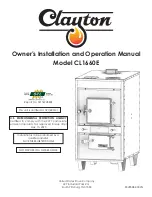
INSTALLATION INSTRUCTIONS
Gas Furnace: (F/G)9MVE
38
440 01 4401 02
Specifications subject to change without notice.
Figure 42
Vent Coupling and Adapter with
Gaskets
Attach gaskets to vent pipe and combustion air adapters
A13074
Vent Coupling and Adapter
Figure 43
Vent Pipe Flush with Adaptor
VENT PIPE ADAPTER WITH GASKET INSTALLED ON FURNACE.
VENT PIPE IS CUT FLUSH WITH TOP OF ADAPTER. PRIME AND
CEMENT VENT PIPE TO ADAPTER. ALLOW TO DRY BEFORE IN-
STALLING VENT COUPLING.
A13076A
Figure 44
Vent Pipe Flush Showing Coupling
ALIGN NOTCHES IN VENT PIPE COUPLING OVER STAND
−
OFF ON ADAPTER. TORQUE LOWER CLAMP 15 LB
−
IN. WHEN
REMAINING VENT PIPE IS INSTALLED, TORQUE UPPER
CL AMP TO 15 LB
−
IN.
A13076B
Locating the Vent Termination
General
NOTE
:
Termination Requirements for the Provinces of
Alberta and Saskatchewan are located at the end of this
section.
Combustion
−
air inlet pipe (Direct Vent/2
−
Pipe system only) and
vent pipe must terminate outside structure, either through
sidewall or roof.
For vent termination clearance, references to National codes
are shown in
for Direct Vent/2
−
Pipe system and
for Ventilated Combustion Air/Non
−
direct
Vent/1
−
Pipe system. For exterior termination arrangements,
refer to
for Direct Vent/2
−
Pipe system and
for Ventilated Combustion Air/Non
−
Direct/1
−
Pipe system.
Contact Local code authorities for other requirements to and/or
exemptions from the National codes shown in the figures.
Roof termination is the recommended termination location.
Roof terminations provide better performance against
sustained prevailing winds. The roof location is preferred since
the vent and combustion air system is less susceptible to
damage or contamination. The termination is usually located
away from adjacent structures or other obstacles such as
inside corners, windows, doors or other appliances. It is less
prone to icing conditions, and it often has less visible vent
vapors.
Sidewall terminations may require sealing or shielding of
building surfaces with a corrosive resistance material due to the
corrosive properties of combustion products from the vent
system, as well as protection of adjacent structures.
NOTICE
RECOMMENDED SUPPORT FOR VENT TERMINATIONS
It is recommended that side-wall vent terminations in excess
of 24 inches (0.6 M) or rooftop terminations in excess of 36
inches (1.0 M) in vertical length be supported by EITHER the
Direct Vent Termination Kit shown in
field-supplied brackets or supports fastened to the structure.
NOTE
: (Direct Vent/2
−
Pipe system ONLY) Terminate with the
standard termination as shown in
or use a
factory
−
approved accessory termination kit.
When determining appropriate location for termination, consider
the following guidelines:
1. Comply with all clearance requirements stated in
2. Termination or termination kit should be positioned where
vent vapors will not damage plants/shrubs, air
conditioning equipment or utility meters.
3. Do not locate termination directly into prevailing winds.
Termination should be positioned so that it will not be
affected by sustained prevailing winds over 30 mph,
wind eddy, such as inside building corners, or by
recirculation of flue gases, airborne leaves, or light snow.
4. Termination or termination kit should be positioned where
it will not be damaged by or subjected to foreign objects
such as stones, balls, etc.
5. Termination or termination kit should be positioned where
vent vapors are not objectionable
.
INSIDE CORNER TERMINATIONS
Corner terminations for Direct Vent (2
−
pipe) terminations are
permitted provided that:
1. The Direct Vent termination is located on the longer of
the two walls.
2. The Direct Vent termination is located at a distance
farther away from the inside corner than the length of the
adjacent wall
















































